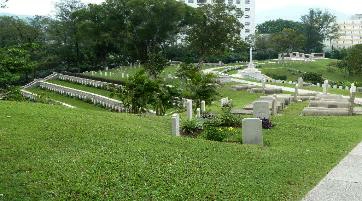| |
The
Lingering Nightmares
In his book, "Royal Rifles of
Canada, A Short History", Arthur G. Penny quotes my father as
the source who provided him with the information that confirmed
what "hitherto had been nothing more than an old soldier's tale,
told whenever two or three had gathered together socially", was
a fact. The "old soldier's story" was ... that as a result of
"D" Company of the Royal Rifles of Canada's failure to lay down
their arms at the appointed time of surrender on the afternoon
of December 25th, the Japanese, in retaliation, massacred the
prisoners in St. Stephen's Hospital. And Penny says of a
statement made by Rifleman Beebe which read, "without any
apparent reason the Japanese bayoneted the wounded ....", Penny
says, "The reason for this outrage, though not clear to Beebe,
is to be found in the continued resistance, described elsewhere,
that "D" Company, (Royal Rifles), disregarded the official
capitulation of the island defenses":
Penny was dead wrong. A simple time check will show that "D"
Company's failure to lay down their arms had nothing to do with
the massacre of the wounded. The murders of the wounded and the
staff of St. Stephen's Hospital took place over 11 hours
earlier, at about 08:00 hrs. Christmas morning. The facts are
clear, the Japanese had no excuse, nor did they need one. Any
guilt my Dad felt was because he may have carried out a
questionable order issued by Wallis that had
wasted so many lives.
A Need to Know and to Remember
The Japanese people may have little, if any, idea what
horrendous acts were committed by some of their men in uniform.
They have a right to know, and a need to remember. These acts
were committed far from Japan, in lands far away, on people they
knew little about, but were committed in their name.
The Canadian people have little, if any, idea what horrendous
acts were perpetrated against their men in uniform. They have a
right to know, and a need to remember. It took tremendous
courage and determination to live in a Japanese prison camp,
under cruel Japanese domination.
Hard Facts About the Battle of Hong Kong
More than 550 Canadians died in the battle for Hong Kong, or in
the 44 months of captivity which followed. It is possible to
suffer a worse fate than to die in battle, on the field. Death
came very slowly to prisoners in the hands of the Japanese. It
came through torture, mental and physical, beatings, starvation,
malnutrition, disease or neglect. It came about because a
Japanese guard felt like having a good time. It came in the form
of an industrial accident, or being worked to death in slave
camps.
A prisoner was 7 times more likely to die in Japanese captivity
than as a soldier fighting on the battle field. The death rate
in European prison camps, from all causes, was four percent. The
death rate in a Japanese prison camp was a staggering
twenty-seven percent.
The number of Canadian soldiers who died in Japanese prison camp
numbered 267, almost as many as were killed during the battle.
Another 200 died prematurely due to health problems acquired
while in captivity.
Stanley Military
Cemetery

These are our dead,
these shattered men who lie beneath this sod,
and
we shall long remember them.
They are in our thoughts and in our hearts we know they are
whole, and live ...
in peace with God.
Ronald
Parker, 2001:
There is a memorial erected
on the island of Hong Kong, at Sai Wan Bay Cemetery. Carved on
panels of Portland stone are 2,071 names. Of those, 283 are the
names of Canadian Soldiers who died in the defense of Hong Kong,
in December of 1941, 107 of them are unidentified. The
dedication panel reads:
“The officers and men whose memory is honoured here died in
the defense of Hong Kong in December 1941 and in the ensuing
years of captivity and have no known grave. It faces North,
towards the mainland, from whence the attack on Hong Kong was
launched. The view is magnificent. The land slopes gently
towards the sea, giving a vista of the glittering water, the
coastline, and the distant hills. Just beyond the village of
Stanley, on the Tai Tam Peninsula is Stanley Military Cemetery
in which lie twenty more Canadians, one of them unknown.
In Memory of The Soldiers of "D" Company or the Royal Rifles of
Canada who died in Hong Kong, Japan, or at home They are heroes
all.”
|
